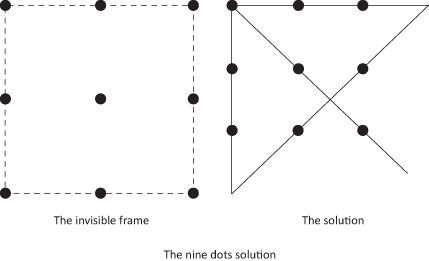Idea 67: The nine dots and the six matches
Brainstorming challenges one kind of unconscious assumption, namely that hammers are for knocking in nails or that scissors are for cutting. But there are other forms of unconscious assumption that may inhibit your thinking.
Take the ‘Nine dots’ and ‘Six matchsticks’ problems in Idea 67. The reason so many people cannot do the first one is that they put an unconscious or invisible framework around the dots, and try to solve the problem within it. That is impossible. But if you break out of that self-imposed limitation, the solution to the problem is easily reached.

Incidentally, I first published the nine dots problem in 1969, in a book called Training for Decisions. It was the origin of a new phrase in the English language, now credited to me: thinking outside the box.
There is a similar assumption made in the six matches problem. People assume that they must arrange the six matches in a pattern of four equilateral triangles in only one plane. If they take one small step and give themselves permission to place the matches on top of one another, they can reach the first solution. But if they break out of the two-dimensional constraint into three dimensions, they achieve the most elegant solution.
Form the matches into a pyramid. The problem cannot be solved on one plane alone; you have to break out into three dimensions. Used immediately after the nine dots it is interesting to note whether or not students can see any relation between them.
